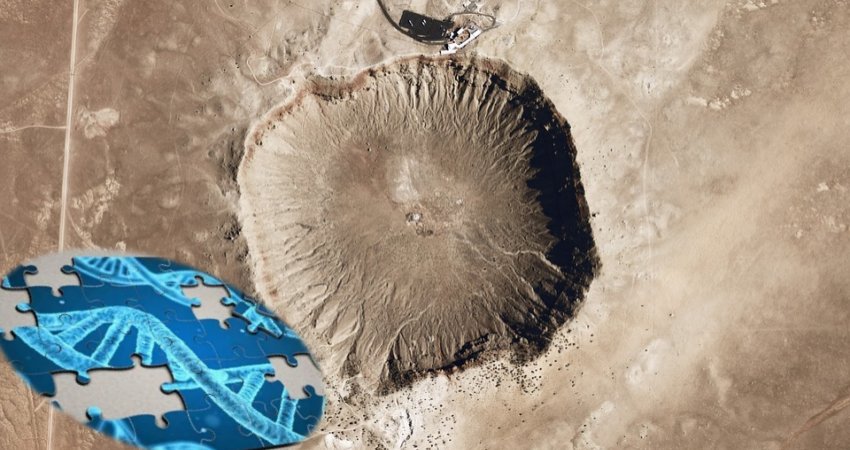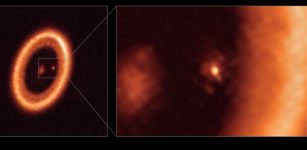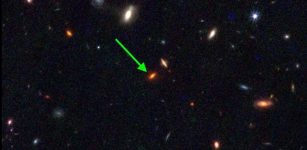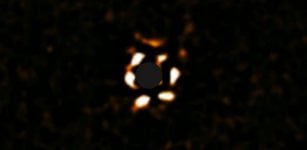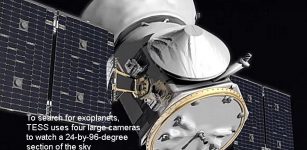First Direct Image Of Beta Pictoris c – Revealed
Eddie Gonzales Jr. – MessageToEagle.com – A team of scientists from the Max Planck Institutes for Astronomy and Extraterrestrial Physics has now observed the faint glint of the planet Beta Pictoris c, some 63 light-years away from Earth, next to the bright rays of its mother star.
Using the GRAVITY instrument at the VLT telescopes in Chile, the astronomers can now determine both the brightness and the dynamic mass of an exoplanet from these observations and thus better narrow down the formation models of these objects.
 These schematic images show the geometry of the Beta Pictoris system: the image on the left shows both the star and the two planets embedded in the dusty disk in the orientation as visible from the vantage point of the Solar System. This view was constructed using the information from actual observations. The middle panel contains an artist’s impression of the disk/planet system. The image on the right shows the dimensions of the system when viewed from above and previous observations of Beta Pictoris b (orange diamonds and red circles) and the new direct observations of Beta Pictoris c (green circles). The exact orbit of planet c is still somewhat uncertain (fuzzy white area). Credit: Axel Quetz / MPIA Graphics Department
These schematic images show the geometry of the Beta Pictoris system: the image on the left shows both the star and the two planets embedded in the dusty disk in the orientation as visible from the vantage point of the Solar System. This view was constructed using the information from actual observations. The middle panel contains an artist’s impression of the disk/planet system. The image on the right shows the dimensions of the system when viewed from above and previous observations of Beta Pictoris b (orange diamonds and red circles) and the new direct observations of Beta Pictoris c (green circles). The exact orbit of planet c is still somewhat uncertain (fuzzy white area). Credit: Axel Quetz / MPIA Graphics Department
The planet called “b Pictoris c” is the second planet found to orbit its parent star. It was originally detected by the so-called ‘radial velocity’, which measures the drag and pull on the parent star due to the planet’s orbit. b Pictoris c is so close to its parent star that even the best telescopes were not able to directly image the planet so far.
“This is the first direct confirmation of a planet detected by the radial velocity method”, says Sylvestre Lacour, leader of the ExoGRAVITY observing program, in a press release.
Radial velocity measurements have been used for many decades by astronomers, and have allowed for the detection of hundreds of exoplanets. But never before were the astronomers able to obtain a direct observation of one of those planets.
“It is amazing, what level of detail and sensitivity we can achieve with GRAVITY”, marvels Frank Eisenhauer, the lead scientist of the GRAVITY project at MPE.
“We are just starting to explore stunning new worlds, from the supermassive black hole at the center of our galaxy to planets outside the solar system.”
The direct detection with GRAVITY, however, was only possible due to new radial velocity data precisely establishing the orbital motion of b Pictoris c, presented in a second paper published also today. This enabled the team to precisely pinpoint and predict the expected position of the planet so that GRAVITY was able to find it.
b Pictoris c is thus the first planet that has been detected and confirmed with both methods, radial velocity measurements and direct imaging. In addition to the independent confirmation of the exoplanet, the astronomers can now combine the knowledge from these two previously separate techniques. “This means, we can now obtain both the brightness and the mass of this exoplanet,” explains Mathias Nowak, the lead author on the GRAVITY discovery paper.
“As a general rule, the more massive the planet, the more luminous it is.”
In this case, however, the data on the two planets is somewhat puzzling: The light coming from b Pictoris c is six times fainter than its larger sibling, b Pictoris b. b Pictoris c has 8 times the mass of Jupiter. So how massive is b Pictoris b? Radial velocity data will ultimately answer this question, but it will take a long time to get enough data: one full orbit for planet b around its star takes 28 of our years!
“We used GRAVITY before to obtain spectra of other directly imaged exoplanets, which themselves already contained hints on their formation process”, adds Paul Molliere, who as postdoc at MPIA is modelling exoplanet spectra.
“This brightness measurement of b Pictoris c, combined with its mass, is a particularly important step to constraining our planet formation models.” Additional data might also be provided by GRAVITY+, the next generation instrument, which is already under development.
Written by Eddie Gonzales Jr. – MessageToEagle.com Staff

